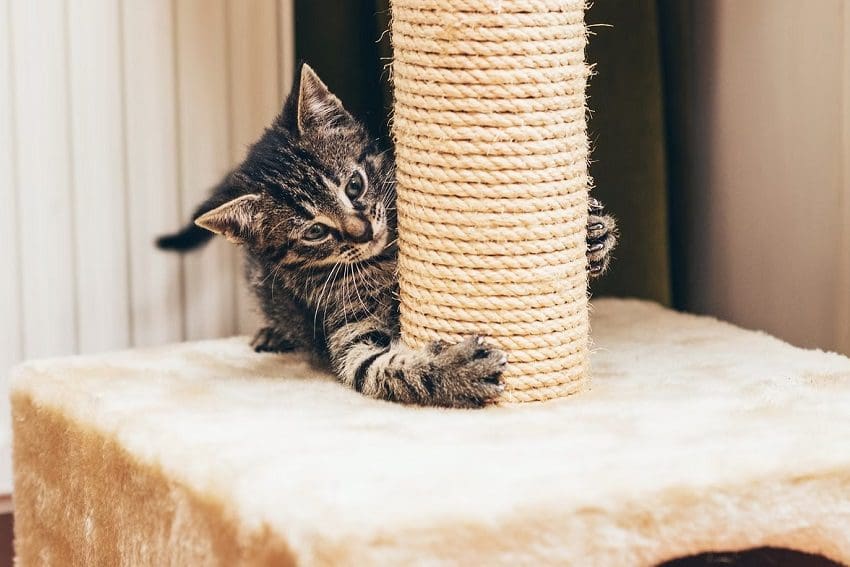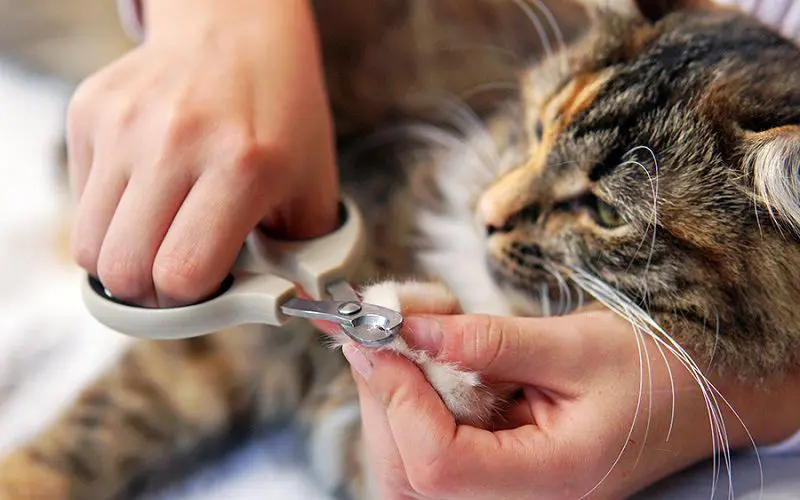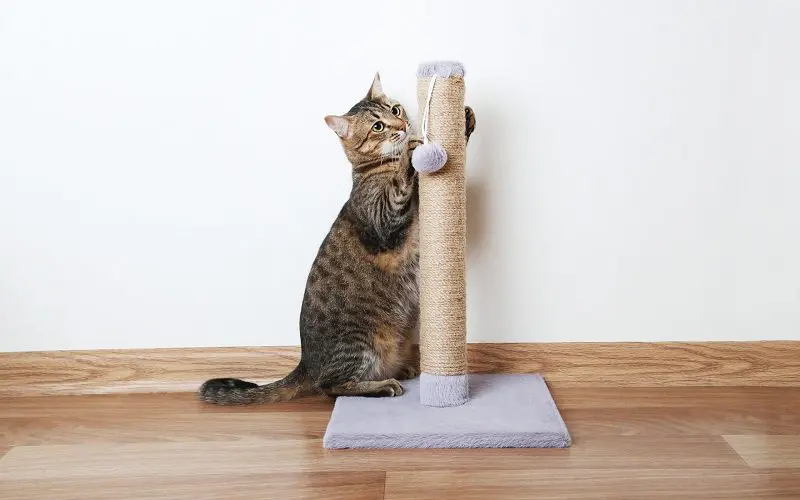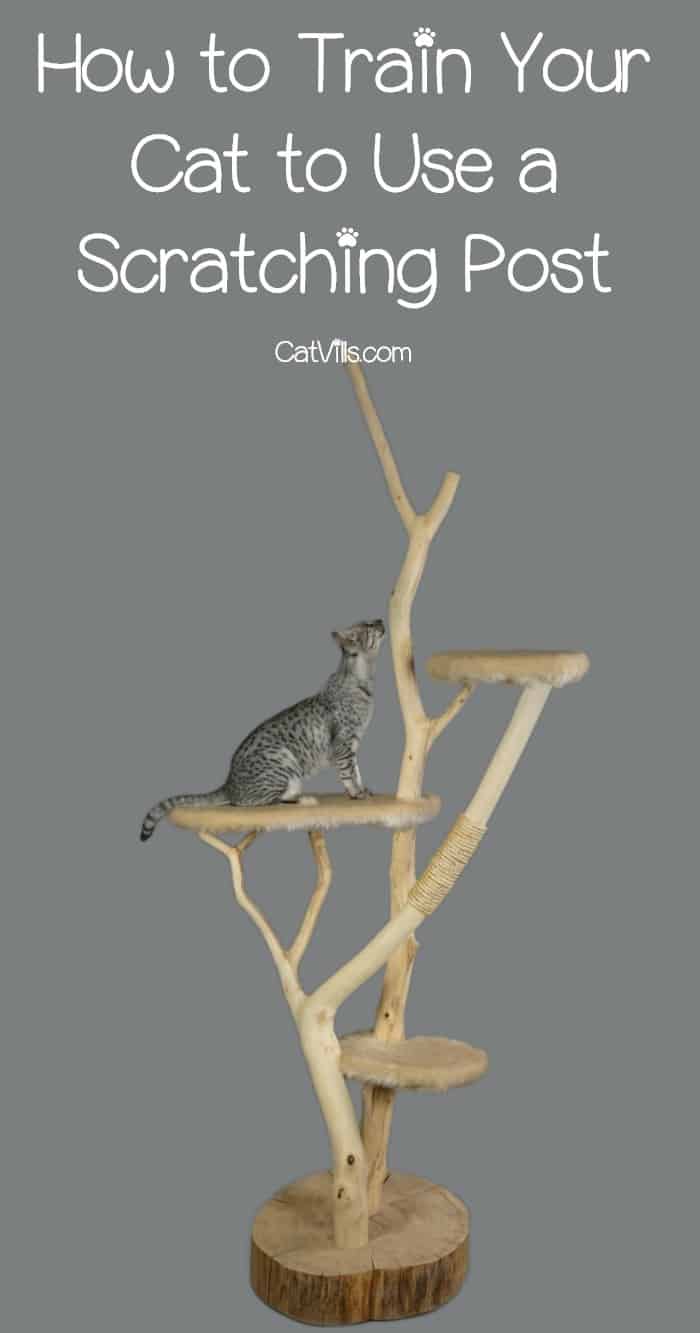Last Updated: 4 months ago
Introducing a scratching post into your cat’s life can save your furniture and provide them with an outlet for their natural instincts.
We’ll explore effective methods on how to train your cat to use a scratching post, ensuring a harmonious coexistence between your feline friend and your home décor.
Learn how to save your furniture and walls from your cat’s claws.
How To Train A Cat To Use A Scratching Post

What if you buy scratching post or make one for your cat and they don’t use it? These three tips, used together or separately, will help.
1. Don’t Spend Too Much Money
The first thing I recommend, to avoid spending any more money, is behavior modification.
If you catch your cat scratching something they shouldn’t be, pick them up immediately (but carefully) and take them to the scratching post.
Gently rub their paws on the surface and praise them while you do—then praise them even more enthusiastically if they take a couple of swipes on their own.
2. Be Patient
Avoid getting angry if at all possible; they are just learning and don’t yet know the rules of the house when it comes to scratching.
If you have had them a while and sprayed them with water or yelled when they have scratched, they may be associating scratching in general with punishment.
Instead of happily using the scratching post, they will continue to use whatever they want, just when you’re not looking.
3. Entice Your Cat
If your cat is still resisting the post or pad, you may need to entice them.
This can be done with treats or toys at the base, then on top of the post, and by playing with interactive toys in a manner that brings the cat nearest to or onto the post.
The other tactic I would use is catnip – it can be a great tool, as it is harmless to your cat, fun for them, and great entertainment for you.
It can be purchased at pet stores dried, as a spray, or as a live plant, which can be kept indoors or outdoors but should be out of your cat’s reach if they are unsupervised.
In Summary
Most of all, be patient. You may have to experiment with different locations for your scratching post, and it may not happen overnight.
Kittens tend to pick up on rules pretty quickly, but like toddlers, they will test their limits.
Adult cats, on the other hand, may be slower to learn. On the other hand, they may surprise you.
Should You Declaw Your Cat?

The answer is plain and simple: no.
There was a time not long ago when the generally accepted process for preserving your furniture around a cat was to have them declawed.
Over the past few years, however, declawing has become a very controversial topic (for good reason), and many vets will no longer even perform the surgery.
Your cat’s claws are essential for their ability to climb and, should they ever get outside, a valuable defense against predators.
While some cats come through unscathed, there can be nerve complications with their feet as a result of the procedure. Cats with claws, however, need to scratch.
It helps keep their claws sharp and healthy by removing dead layers from them; it is great exercise, the stretching involved helps keep them limber; and it keeps them from getting bored.
If you think they can be destructive now, wait until the boredom sets in and they get a little stir-crazy.
This doesn’t mean, however, that you are doomed to have shredded couches and decimated carpets for the entirety of your cat-parenting life.
Keep Your Furniture Safe
Discover effective strategies and useful products that will not only preserve the integrity of your furnishings but also ensure a harmonious living space for both you and your cat.
Say goodbye to scratched surfaces and hello to a home where your cat can express its natural instincts without compromising your furniture.
1. Trim your cat’s nails

There are a number of creative solutions and products on the market to keep your cat from destroying your possessions.
Before spending money on any of them, you should first get a set of clippers for your cat’s claws and get your pet used to having them handled.
Keeping the claws trimmed helps keep them from getting caught on anything, which can result in serious injuries to the claws themselves, paws, limbs, or worse, depending on the situation.
Trimming your cat’s nails will never be a waste of time, as it can be combined with other methods to protect your furniture and floors.
2. Use sprays to keep them away
Investing in cat repellent sprays can help deter your cat from specific areas of your home.
However, if you’ve had the misfortune of accidentally tasting one, you might reconsider using it on surfaces you come into contact with regularly.
3. Cap their nails

You can use a set of caps for your pet’s nails to complete this step.
Cap nails caps are available for both cats and dogs, in multiple sizes, and in multiple designs.
These nail caps easily slide onto your pet’s claws, attaching with a safe epoxy. However, they tend to come off and require regular reapplication.
Keeping your cat calm and still during this process might sound simple, but I found it to be quite challenging.
4. Try double-sided tape
You can also get two-sided tape to apply to your furniture so that your cat’s paws will stick to it a little as they scratch, and it may be unpleasant enough to deter them.
Depending on the fabric of your couch, however, this might be damaging to the surface, and it isn’t particularly attractive if the sides and/or back of your couch are visible.
Things You Can Get For Your Cat
Let’s explore a variety of options to enhance your cat’s environment and discourage unwanted scratching behavior.
Here are some items that can make a significant difference in preserving your furniture and maintaining a harmonious home with your furry friend.
1. Provide Your Cat a Scratching Post

Overall, the best, easiest, and least expensive method in the long run to minimize feline-inflicted damage is to provide your pet with a scratching post or pad.
The greatest thing about scratching posts is that you can scale them to your living space, your budget, your style, and your carpentry and crafting skills.
A simple piece of 4×4 attached to a small piece of plywood as a base and covered in a piece of carpet remnant is all you need, but you can make this into far more than just a post for your cat to sharpen their claws on.
2. Build DIY Climbing Platform
Cats love to climb, and you can build a structure for them that is 5 or 6 feet high, with multiple platforms and levels for them to climb, jump to, scratch, and even nap on.
You can build a six-foot-tall piece of art that would resemble an acutal tree. It should have a center post, with holes cut out at each of the three levels for the cats to hide in and find their own zen space.
Large, sturdy platforms constructed to roughly resemble boughs make great vantage points for the cats to watch the goings-on in the house, and their placement near a window ensures they aren’t missing anything out there.
The benefit of a structure like this is that not only is it great exercise and mental stimulation for your pet, but it also forces them to unintentionally use the scratching post in the meantime.
3. Get A Cat Tree

While they are more costly, cat trees and playgrounds can be purchased ready-made at pet stores.
You can also start a DIY project, begin building it, and improve it over time.
Small, inexpensive boxes with corrugated cardboard inserts can also be purchased if money and/or space are concerns, as cats seem to like the feel of them for scratching as well.
Wrap-Up
Training your cat to use a scratching post is a rewarding journey that enhances the well-being of your feline friend and promotes a scratch-friendly environment.
By implementing these tips and selecting the right tools, you’ve taken a positive step towards nurturing a happy and scratch-savvy companion.
Remember, patience and consistency are key, and your efforts will surely pay off with a content and well-behaved cat.
Did you train your cat to use a scratching post? What methods worked best for you? Share in the comments below!
Resources:


